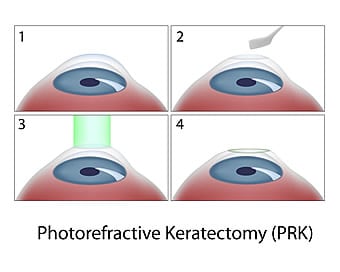PRK/ASA Eye Surgery
If you are considering laser eye surgery, PRK (also referred to as ASA) eye surgery is an excellent alternative to LASIK or SMILE. The PRK procedure is a particularly good option for people who have been told that they would not be good candidates for LASIK eye surgery, or for people whose lifestyles may have precluded them from having LASIK.
Patients who are often recommended for PRK Laser Eye Surgery are those who:
- Have a cornea that is thinner than what is advised for LASIK
- Have dry eyes or are prone to dryness
- Participate in high-contact sports (such as MMA fighting) and are more likely to take a hit to the eyes
How PRK Eye Surgery Works

- Numbing drops applied
- Superficial layer scraping
- Laser sculpting
- The corneal surface heals; in myopes, the cornea is made flatter.
PRK Eye Surgery Healing Expectations
A person who had PRK laser eye surgery can expect to see every bit as well as a LASIK patient over time. The initial healing period is much slower. Patients are often recommended to have one eye done at a time. The doctor may recommend waiting anywhere between a week to a month between eyes. Having one eye done at a time will help patients to remain functional throughout healing. Patient who has one eye done at a time will need to make arrangements to have their glasses adjusted or to wear a contact lens in between procedures.
In most cases, a PRK patient will wear a contact lens during the first 5-8 days of healing. In most cases, the patient will not need to touch the lens at all. The ophthalmologist will handle putting the lens in and taking the lens out.
Benefits of the PRK Procedure
- Preserves the Structural Integrity of the Cornea: In an Advanced Surface Treatment, the laser correction is performed on the surface of the cornea rather than a deeper layer.
- Puts Patients at Less Risk of Corneal Complications: Patients are at less risk of experiencing corneal injuries than with LASIK. Blunt trauma to the eye can cause a dislodged flap in some cases even years after the LASIK procedure.
- Better for Patients with Thin Corneas: Working on the surface of the cornea also allows for the treatment of patients whose corneas are too thin for the creation of a LASIK flap and removal of tissue by the excimer laser.
- Less Likely to Induce or Worsen Dry Eye: Advanced Surface Ablation is gentler on corneal nerves and thus diminishes the possibility of inducing or worsening dry eye syndrome.
PRK vs. LASIK
While both procedures use the same advanced laser technology to reshape the cornea, the method of accessing the treatment area differs.
PRK: The “No-Flap” Solution
- Best For: Thin corneas, dry eyes, and high-impact lifestyles (Military/Police).
- The Procedure: We gently remove the thin outer layer of the cornea; no flap is created.
- The Recovery: A “bandage lens” protects the eye for 3–5 days while the surface regrows.
- The Benefit: Maximum corneal structural integrity and zero risk of flap complications.
LASIK: The “Quick-Recovery” Standard
- Best For: Most patients with standard corneal thickness seeking immediate results.
- The Procedure: A small, precise flap is created to treat the underlying tissue.
- The Recovery: Most patients return to normal activities within 24 hours.
- The Benefit: Rapid visual recovery and minimal post-operative discomfort.
Want to learn more? The best way to find out what you would be a candidate for is to have a free consultation. Schedule a free consultation today!





